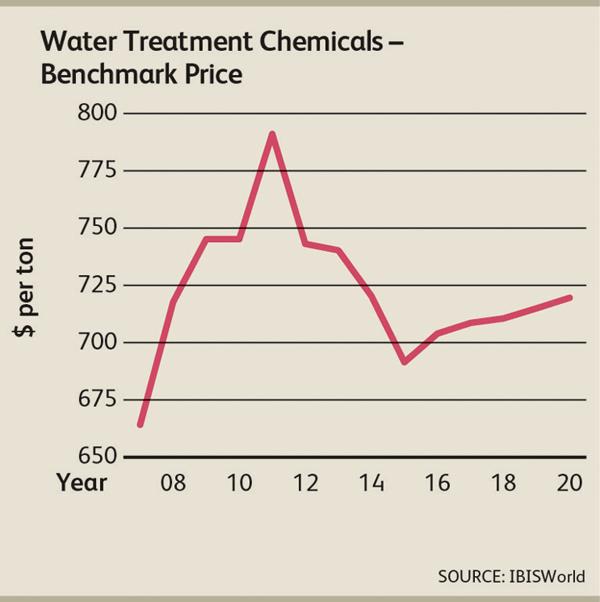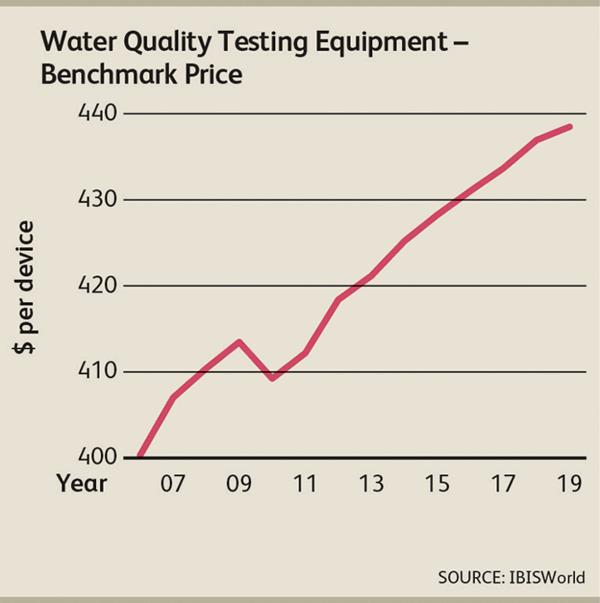Getting The Lead Out
By Anna Son, procurement research analyst, IBISWorld
The Flint water crisis was a wake-up call for government authorities, municipalities, and private entities to recognize the need to upgrade the outdated water supply systems across the nation. In April 2014, the city of Flint, MI, switched its drinking water source from Detroit’s system to the Flint River. The switch led to a sequence of events that culminated in lead contamination in the city’s water supply. Unfortunately, water crisis and lead contamination threats are not unique to Flint. Major U.S. cities like Detroit and Philadelphia are discovering issues with their own old water pipes. These pipes can cause adverse, long-term health implications for individuals, particularly children, who drink the water that flows through them. As a result, ensuring the quality and safety of drinking water across the U.S. EPA-monitored 155,000 public water systems has become a national issue.
While no easy and quick solution exists that can fix the public water crisis, IBISWorld suggests several solutions that municipalities and businesses can implement, at least in the short term. These potential solutions range from using different water treatment chemicals to performing regular water testing and upgrading filtration systems. Investing in preventive measures will not only help mitigate the risk of disease outbreaks caused by consuming contaminated water, but can also bring cost savings and improved operational efficiency to those that implement them.
Sources Of Drinking Water
In light of growing health-related concerns associated with the risk of lead and other toxic substance contamination, as well as the high cost of replacing old pipes, many establishments have been looking for alternative solutions to drinking fountains. Further, there has been a rise in the popularity of ecofriendly reusable water bottles. As such, these factors together have motivated businesses, schools, and other public establishments to install water coolers, bottle-filling stations, and filtration systems to supply their patrons, students, and citizens with healthy drinking water. Unfortunately for businesses, prices for water coolers have been increasing. IBISWorld estimates water coolers cost between $150 and $500 on average. Installation costs for water coolers, though, are substantially lower than drinking fountains because there is no construction required. Nonetheless, there are ongoing operating and maintenance costs, such as cup and filter replacements, which water cooler owners should consider.
Water delivery services are also a viable option that accompanies purchasing water coolers and dispensers. IBISWorld estimates the average price of delivering a full five-gallon water bottle costs about $6.45. However, prices can vary moderately depending on the order volume, delivery region, cooler, and water type. For example, spring and purified water is less expensive than distilled or fluoridated water.
Still, a large number of schools, hospitals, and other public establishments continue to rely on traditional, decades-old drinking fountains because federal regulations require them in public places. Regardless of the drinking water source that buyers choose, ensuring the quality and safety of drinking water should be the foremost concern of both public and private water supply providers. While overhauling the outdated drinking water and wastewater infrastructure across the country will take years and billions of dollars to complete, buyers can look into the following preventive measures.
Altering Water Treatment Practices
In order to guarantee drinking water’s quality and safety before it reaches homes and public places, water supply providers add treatment chemicals, such as aluminum- and iron-based coagulants, to purify and filter the water supply. Water supply providers also add corrosion inhibitors to extend the useful life of water pipes and further protect against from lead seeping into the water. The improper use of water treatment chemicals or the failure of adding corrosion inhibitors to the water supply can have disastrous consequences, though. This was the case in Flint when, in a misaligned cost-saving measure, city officials switched to sourcing their drinking water from the Flint River without applying any corrosion inhibitors. That decision was ruinous, teaching other municipalities and private water supply providers an important lesson in employing adequate water treatment practices. While the cost of replacing old, corroded water pipes, let alone the entire infrastructure, is exorbitant, altering water treatment practices can be a viable and affordable alternative in the short term.
According to a study conducted by Australian scientists at the University of Queensland, replacing aluminum sulfate coagulants with sulfate-free compounds, such as ferric chloride, can help reduce pipe corrosion over time. The study showed that using nonsulfate coagulants helps reduce pipe corrosion by 60 percent over a long period of time. Although aluminum sulfate coagulants are among the least expensive water treatment chemicals, buyers should consider the potential drawbacks, such as pipe corrosion, associated with using aluminum sulfate coagulants. Given the surplus of suppliers in the water treatment chemical market that leads to stiff market competition, buyers can leverage suppliers’ offers against others in order to elicit lower prices. Suppliers are also more inclined to come down on price when buyers purchase in bulk or enter into long-term supply agreements.

Another way of ensuring water safety and quality is through the use of membrane filters. Due to their small pore size that can remove viral contaminants, membrane filters are being used increasingly for drinking water and wastewater treatment. The implementation of membrane filters in drinking water treatment has skyrocketed in recent years, mainly due to government efforts to reinforce drinking water quality standards and raise public awareness about pathogen outbreaks. While IBISWorld estimates the average price of membrane filters is about $3.98 per filter, prices can vary greatly depending on the product type, pore size, and thickness, as well as material type. Given the large variety of membrane filters available in the market and steady price growth in the past three years, buyers should carefully evaluate their filtration needs before making purchases.
Water Quality Testing Equipment And Services
Employing water quality testing equipment is another effective method of detecting contamination and the physical properties of water. The two primary types of equipment used to assess the quality of water are electronic devices, also known as electronic metering devices, and chemical-based testing kits. Electronic metering devices are typically handheld control units with a sensor probe that, when submerged in water, will detect the various substances therein and present the results on a built-in display. Similarly, chemical-based testing kits use numerous chemicals that are first mixed with a water sample. Then, the test chemicals will react and change their physical properties according to the presence of any contaminants in the water sample. IBISWorld estimates that chemical kits cost an average of around $70 per kit, and are generally priced significantly lower than electronic devices that cost about $430 on average. For buyers seeking to use testing equipment to determine the contamination level of water, the test’s level of accuracy and consistency is paramount. Durability is another important qualitative factor to consider because water quality testing equipment is frequently transported to various locations and subjected to different outdoor and indoor environments. Fortunately, the water quality testing equipment market is fragmented and highly competitive, which boosts buyers’ ability to negotiate lower product prices. In order to further ensure the safety and quality of drinking water, buyers should consider using water quality testing services. Besides testing the safety and content of water, service providers ensure its compliance with all applicable EPA regulations. While the average price for water quality testing services is estimated at $195 per water sample, prices can vary widely depending on the number of tests being completed, type of tests, and whether the testing is done onsite or in a laboratory. Service providers typically perform more than one test in order to properly establish the quality of the water in question. Common tests include E. coli, lead, and coliform tests, but there is a wide range of tests that buyers may require depending on their needs. Again, this market is fragmented and fierce competition prompts service providers to offer competitive prices to buyers in order to win and retain business. Moreover, an excess of service providers and their wide geographic distribution across the country give buyers many options.

The Future of Water
While overhauling outdated water supply infrastructures will take years and billions of dollars to complete, municipalities and businesses should begin immediately to look for short-term solutions. Investing in preventative measures will help mitigate the risk of disease outbreaks and prevent water crises from happening in other parts of the country. Moreover, it is important for municipalities and businesses to remember that potential cost savings should not come at the expense of public health.
